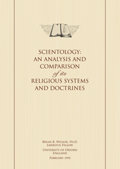I.I. Elements of the Definition of Religion
There is no one definitive definition of religion that is generally accepted by scholars. Among the many definitions that have been advanced there are, however, a number of elements that are frequently invoked. These elements appear in various combinations. They include:
(a) Beliefs, practices, relationships and institutions relative to:
1) supernatural forces, beings, or goals;
2) higher unseen power or powers;
3) man’s ultimate concern;
4) sacred things (things set apart and forbidden);
5) an object of spiritual devotion;
6) an agency that controls man’s destiny;
7) the ground of being;
8) a source of transcendent knowledge and wisdom;
(b) Practices which constitute obedience, reverence or worship;
(c) The collective or group character of religious life.
Although causes are rarely included in definitions of religion, “an experiential encounter with the spiritual” is sometimes indicated. The consequences and functions of religion are indicated as:
(a) maintenance of a moral community;
(b) the conferment of group and/or individual identity;
(c) a framework of orientation;
(d) a humanly constructed universe of meaning;
(e) reassurance and comfort respecting prospects of help and salvation.
Religion is always normative, but since each religion differs from others, modern specialists in the sociology of religion and comparative religion seek to discuss the normative without themselves becoming committed to it. Such is the diversity of patterns of belief, ritual, and organization, however, that any definition of religion is strained in attempting to encompass all the manifestations of religion that are known.
I.II. The Original Use of the Concept
The concept “religion” was formerly often identified with actual concrete manifestations of beliefs and practices in Western society. Apart from Christians, Jews and Muslims, it was generally held that other peoples had no religion in the proper sense. They were “heathens.” Theologians who used the term “religion” tended to mean by it Christianity, and in England reference to “Christianity” was often taken to mean that faith as purveyed specifically by the Church of England. That restricted usage has steadily receded as more has become known of oriental belief-systems, and as the study of religion has transcended the narrow normative prescriptive restraints of traditional Christian theology. Religion has become an object of study for academic disciplines—in particular the social sciences—which approach that subject objectively and neutrally and without any implication of adherence to any one particular religion, or a preference for one above another.
I.III. Cultural Bias and the Definition of Religion
The development of a thoroughgoing neutrality in the study of religion was achieved only slowly, however. Some contemporary studies in comparative religion still manifest evident bias. Even in the social sciences, explicitly committed to value-free enquiry, certain prejudices are apparent in work done in the inter-war years. In particular, it was often gratuitously assumed that there had occurred a process of religious evolution analogous to that of biological evolution and that the religion of the most advanced nations was necessarily “higher” than that of other peoples. For some (conspicuously Sir James Frazer) it was believed that religion was an evolutionary step on the road from magic to science.
I.IV. Contemporary Usage
Today social scientists and increasingly theologians employ the concept as a neutral expression, no longer implying any a priori assumptions about the greater truth of one religion over another. It is not now assumed that belief in one deity is necessarily a higher form of religion than belief in several deities or in none. It is recognized that a religion may postulate an anthropomorphic god, some other form of deity, a supreme being, a plurality of spirits or ancestors, a universal principle or law, or some other expression of ultimate belief. Some Christian theologians such as Bultmann, Tillich, van Buren and Robinson have abandoned traditional depictions of deity, and prefer to refer to “the ground of being” or “ultimate concern.”
I.V. Extension of the Concept
As anthropologists came to maintain that there was no clear instance of a society that lacked all forms of supernatural beliefs and institutions that supported such beliefs, so they concluded that, in the wider sense of the term, there was no society without religion. The concept “religion” came to connote phenomena that had family resemblance rather than shared identity, and religion ceased to be defined in terms specific to one particular tradition. The concrete items that pertained to Christianity, and which had been regarded as essential to the definition of religion, were now seen to be merely examples of what a definition might include. The specification of such concrete elements was superseded by more abstract formulations which embraced a variety of types of beliefs, practices and institutions which, although far from intrinsically identical, could be regarded as functional equivalents. Every society was perceived to have beliefs that, although diverse, transcended known empirical reality and had practices designed to bring men into contact or rapport with the supernatural. In most societies, there were people who undertook the special functions associated with respect to this goal. Together, these elements came to be recognized as constituting religion.
I.VI. Religious Diversity in Simple Societies
In relatively small, tribal societies there are often rites and myths of considerable complexity which do not usually constitute one consistent, internally integrated and coherent system. Religion undergoes change, and accretion occurs in both myth and ritual as a society experiences contact with neighbouring or invading peoples. Different rites and beliefs may be attached to different situations (e.g., to induce rain, to ensure fertility in crops, animals and women; to provide protection; to cement alliances; to initiate age-groups or individuals, etc.). All such activities are directed towards supernatural agencies (however defined) and they are recognized by scholars as religious.
I.VII. Religious Diversity in Advanced Societies
The codes of religious belief and practice in technically more advanced societies are generally more elaborately articulated and display greater internal coherence and stability, but even in advanced systems, elements of diversity persist. No theological system or schematization of beliefs pertaining to the supernatural, in any of the world’s great religions, is wholly coherent. There are always unexplained residues. There are also remnants of earlier religious orientations such as folk religious elements which persist among the general populace. The sacred scriptures of all major religions manifest internal contradictions and inconsistencies. These and other sources give rise to differences among religious specialists who embrace different and at times irreconcilable interpretative schemes and exegetical principles, which feed different traditions even within what is broadly acknowledged to be orthodoxy.
I.VIII. Development of Religious Pluralism
In advanced societies, deliberate and conscious dissent from orthodoxy must be regarded as a normal phenomenon. Christians, Jews and Muslims are divided, not only within orthodoxy, but by dissentient groups which reject all forms of orthodoxy and which follow a divergent pattern of religious practice (or who reject religion altogether). Dissent is most conspicuous in contexts in which religious exclusivity prevails: that is to say, in which the individual is required, if adhering to one religion, to renounce allegiance to all others—a pattern of commitment rigorously required in the Judaeo-Christian-Islamic traditions. As state governments have ceased to prescribe specific forms of religion, dissenting religious bodies have been both tolerated and granted certain general religious privileges in European countries, and have come in many cases to enjoy the general freedom of religion embraced constitutionally in the United States. The situation which obtains today of a large number of different denominations operating side-by-side is known as “religious pluralism.”
I.IX. Normative and Neutral Approaches to Religion
A religion characteristically sets out certain stories (myths) and propositions respecting the supernatural which are expected to command belief. It prescribes ritual performances. It sustains institutions (in the broad sense of regulated relationships, whether at a rudimentary personal level or as a complex system of behaviour, procedures and property-maintenance). It sometimes also stipulates rules of moral conduct, although the rigour of such stipulation and the sanctions attached to morality vary considerably. But, at least, religion defines obligations and promises rewards for conformity in the shape of supernaturally provided benefits. Religion constitutes a normative system. Religious teachers (“theologians” in Christianity—but the term is inappropriate for some other religions) necessarily endorse and enjoin these norms. In contrast, social scientists regard the values which a religion canvasses merely as facts, neither endorsing nor denying their warrant or their worth. This approach resembles that of those formulations of the law which declare that the law does not discriminate among religions. Because religion is normative and intellectually has been mainly the preserve of theologians, there is, in all advanced societies, an inheritance of learned language about religion which bears the normative stamp of religious commitment. It is deemed essential here to avoid the value-preference implicit in such language and to employ the neutral terminology of the social sciences, whilst seeking to maintain an appropriate sensitivity to those engaged in religious activity.
If religions are to be accorded parity, it becomes necessary to adopt abstract definitive terms to encompass the diversity of religious phenomena.
I.X. ‘Borrowed’ Nomenclature
Early definitions and descriptions of the essentials of religion frequently used terms borrowed from the religious traditions of those who formulated them. It is now recognized that the use of terms peculiar to one religion must distort the depiction of other religions, and may frequently involve false assumptions. Concepts evolved within one cultural and religious tradition will misrepresent the functionally equivalent but formally distinctive elements of religion in another. Instances of such inappropriate usage include reference to “the Buddhist church”, “the Muslim priesthood” or, in reference to the Trinity, “Christian gods.” Similarly, although acts of reverence, obeisance, contemplation, or dedication occur in all advanced religions, commentators have not always recognized them as worship because, in Western usage, that term has been heavily loaded with Christian preconceptions and prescriptions concerning appropriate attitudes and actions. For example, the functional equivalent of Christian worship in cultivating the dispositions of worshippers occurs in Buddhism but its form is different and it is normally described by other terms. Thus, if religions are to be accorded parity, it becomes necessary to adopt abstract definitive terms to encompass the diversity of religious phenomena.
I.XI. The Inherent Deficiency of Abstract
or Objective Analysis
This use of abstract language, which may be regarded as “clinical” in the sense of not being contaminated by the particular traditions of any one religion, will necessarily fail to capture all the intrinsic qualities of any specific faith but it is a necessity if an appraisal is to be achieved. It will exhaust neither the cognitive nor the emotional aspects of belief, ritual, symbolism and institutions. This social scientific approach makes possible objective comparison and explanation, but it does not, and does not pretend to, convey the whole substance of the inner meaning or emotional appeal that a religion has for its own adherents.





























